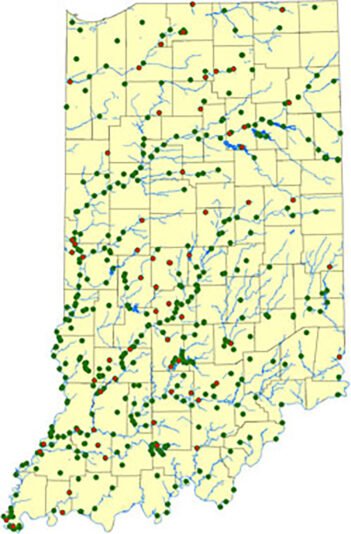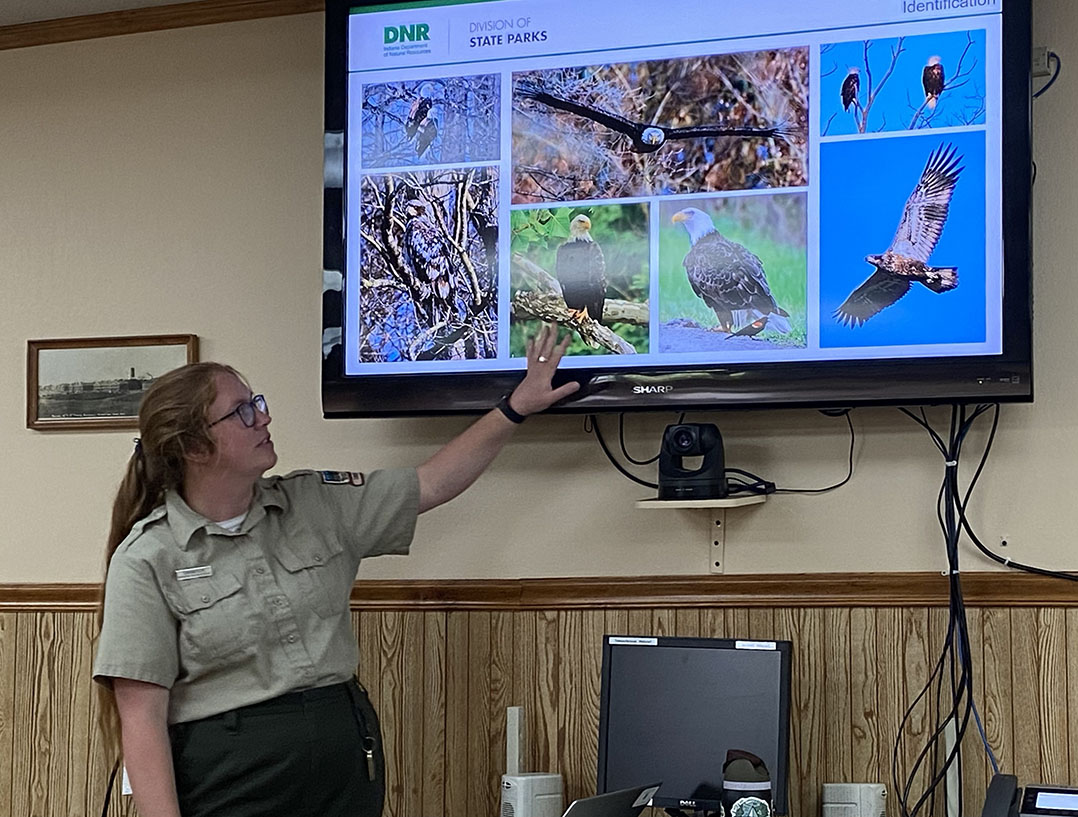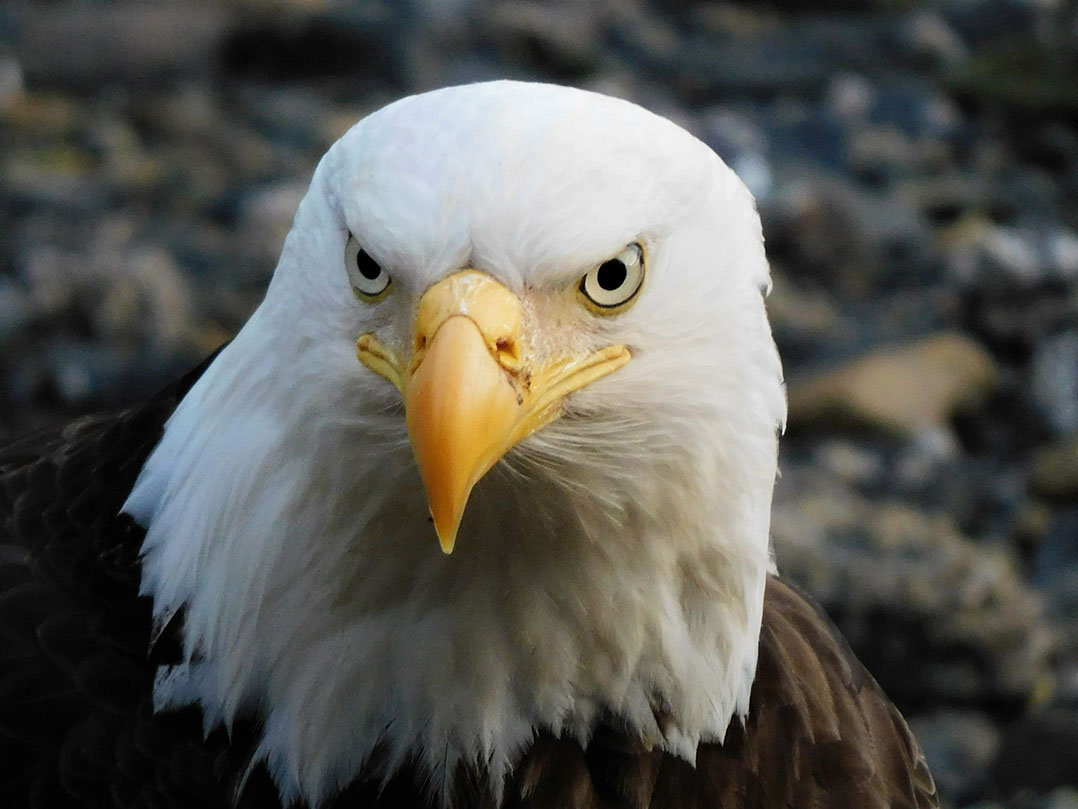Bald eagles were an endangered species in Indiana — and many other states —well into the 1980s. A combination of hunting before they became protected, habitat loss and the use of the now-banned pesticide DDT caused the population to plummet.
Sarah Fox is an interpreter at Fort Harrison State Park and led a presentation about bald eagles to a small but eager audience on, appropriately, the Fourth of July. She said things looked bad for a while in Indiana for bald eagles until the state reintroduced the species between 1985 and 1989.
“In this project, they brought in 73 eagles from Alaska,” she said. “They were brought in at about seven to eight weeks (old), and the folks that were taking care of them were feeding them and watching them every single day, making sure they were surviving until they reached about 11 or 12 weeks, when they were able to successfully leave the nest on their own and start fending for themselves.”
That program, which also brought eaglets from Wisconsin, took place at Lake Monroe near Bloomington. Fox said the first eagle nest from that group of transplanted birds was spotted in 1991.


“After we brought in those 73 eagles, they started repopulating, and it just kind of boomed from there,” she said. “It was so successful that by 2008, bald eagles went from being endangered (in Indiana) to only of special concern.”
And in 2020, she said, with more than 350 nesting sites in Indiana, eagles were upgraded again to “common.” They remain a federally protected species, however. It’s illegal to hunt them or disturb a nest.
Fox said one bird from the original transplanted group is still alive. It, along with all the others, was banded, which allows biologists to keep track of each bird. Fox said C-43, a female, is now in her late 30s, making her one of the oldest-known wild bald eagles.
Fox gave an overview of bald eagles, including how to identify them. The adults are easy, with their snow-white heads and tails, but bald eagles don’t get those trademark feathers until they’re about 4 years old. Juveniles have a brown-and-white mottled look all over, which could be a form of camouflage to protect them as they mature.
Fox said eagles also have a bright-yellow hooked beak and yellow feet, can reach nearly 40 inches in height, and have a wingspan of up to 8 feet.
Fox said eagles prefer a habitat with large bodies of water, for easy access to their primary food source.
“They like to eat fish,” she said. “But really, they’re kind of opportunistic. They’ll eat whatever they can find. So, if they happen to get a duck in the water, or if there’s some roadkill in the middle of a field, you know, they might go after that as well. They’re not too picky in that regard.”
The bald eagle became a symbol for the United States of America on the heels of independence from Great Britain. The bald eagle is the only eagle species indigenous to North America, and it looks majestic. Fox said Benjamin Franklin was opposed to that choice, though, because he felt bald eagles had poor “moral character.” He advocated for the turkey but was overruled.
Following her presentation, Fox led her audience in a simple craft: Make a bald eagle using a paper bag, construction paper and glue. The kids — and a couple adults — had fun with the activity.
The July 4 presentation is one of many that Fort Harrison State Park hosts throughout the year. Emilie Sweet is the interpretive naturalist at the park, and said when kids are in school, it offers more programs for school groups and Scout troops. In the summer, they switch gears and offer all-ages programs for the general public.
She said they offer guided hikes on various trails in the parks, and presentations on a wide variety of topics — they had recently hosted a program about bats, for example. The center also is home to three live reptiles — two turtles and a rat snake — that they sometimes bring out during a presentation, Sweet said.
“It’s a great place for kids and adults to be able to interact with animals at a safe place for the animal and for the person,” she said. “So, we try to do a decent amount of live-animal programs. We also really like to incorporate crafts into our programs so we can hit the demographic of the younger kids, because inspiring a love for the outdoors when they’re young is really important to us and we want to keep them coming back.”

Fort Harrison State Park program schedule
Fort Harrison State Park offers numerous programs throughout the year. The summer programs are geared toward all ages, while winter programs focus on school-age audiences. Below are upcoming presentations currently listed on the park’s website.
- July 15: The Korean War Display, Fort Harrison State Park
- July 15: Noteworthy Nocturnals, Fort Harrison State Park
- July 15: Fantastic Foxes, Fort Harrison State Park
- July 16: Beginner’s Bird Hike, Fort Harrison State Park
- July 16: The Korean War Display, Fort Harrison State Park
- July 16: Camp Creek Hike, Fort Harrison State Park
- July 17: Turtle Talk, Fort Harrison State Park
- July 21: Great Blue Heron Hangout, Fort Harrison State Park
- July 22: Guided Hike Along Fall Creek, Fort Harrison State Park
- July 22: Leaf Print Painting, Fort Harrison State Park
- July 23: Stunning Salamanders, Fort Harrison State Park
- July 23: Striking Stags, Fort Harrison State Park
- July 24: Sensational Sunshine, Fort Harrison State Park
- July 28: Awesome Opossums, Fort Harrison State Park
- July 29: Woodpecker Walk, Fort Harrison State Park
- July 29: Creek Stomp, Fort Harrison State Park
- July 30: Skulls and Furs, Fort Harrison State Park
- July 30: Outstanding Owls, Fort Harrison State Park
- Aug. 19: Summer Concert Series, Fort Harrison State Park
- Sept. 2: Summer Concert Series, Fort Harrison State Park
- Sept 16: BBQ & Blues Festival, Fort Harrison State Park
For more, visit in.gov/dnr/state-parks/parks-lakes/fort-harrison-state-park/nature-center-and-events.



